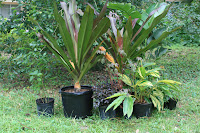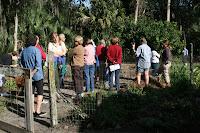
My Christmas present to myself arrived today and I'm none too super happy. Timber Press was running a big sale and I just couldn't resist all the juicy titles. So now my garden library is graced by these new tomes:
Christmas comes early
Saturday, December 15, 2007
Posted by
Kim Taylor Kruse
at
12:52 AM
3
comments
![]()
Labels: books bromeliad bamboo
Acid lovers unite!
Monday, December 3, 2007
Posted by
Kim Taylor Kruse
at
11:14 AM
0
comments
![]()
Labels: Camellia sansanqua, soil test
Sweet blooms
Tuesday, November 20, 2007
One of my new crinums is blooming! I wish I could somehow capture the wonderful fragrance so that the photo could be scratch and sniff. It reminds me a bit of a cross between and orange blossom and jasmine. Absolutely wonderful.
Posted by
Kim Taylor Kruse
at
12:36 AM
2
comments
![]()
Labels: crinum, Crinum procerum, fragrant
Red Wind
Friday, November 9, 2007 Here's another hot plant that was featured on the National Gardening Association's regional electronic newsletter. It's called 'Red Wind' Japanese Hakone Grass, or Hakonechloa macra 'Beni-Kaze'.
Here's another hot plant that was featured on the National Gardening Association's regional electronic newsletter. It's called 'Red Wind' Japanese Hakone Grass, or Hakonechloa macra 'Beni-Kaze'.
This striking ornamental grass is favored for it foliage, which develops reddish tips, especially as fall approaches. It grows in Zones 5-9, reaching 24"-36" in both height and width.
It apparently looks striking cascading down a bank, since it has a slight weeping habit. I don't have any banks that need a cascade, but I'd still consider adding this beauty to my landscape!
For more information, visit Klehm's Song Sparrow Farms.
Posted by
Kim Taylor Kruse
at
9:57 AM
0
comments
![]()
Labels: hakonechloa macra beni-kaze, japanes hakone grass, ornamental grass
Soil testing
Monday, October 29, 2007
In the interest of following through with what most Extension folks recommend, I'm finally getting my soil tested. Here is what the sample looked like before I bagged it up and dropped it off at the soils lab. The idea is that you take several samples from around the yard, mix them up in a bucket, and then spread out a few cups worth on newspaper or a brown shopping bag to dry. Then you package the soil and drop it off at the soil lab. You can either select to learn the pH and lime requirement, or you can go whole-hog and get the soil fertility tested. The latter test provides pH and lime requirements and also reveals the presence or absence of other nutrients--phosphorous, potassium, calcium, and magnesium. I should get my results back within two weeks.
Cross Creek
Thursday, October 25, 2007 We also wandered the grounds and looked at the many citrus trees on the property. This image shows freeze damage. Wendy Wilber, Extension agent for Alachua County, explained that the sap in the tree stops flowing when temperature drop to freezing on cold nights. In the morning, the sun will begin to heat up one side of the branch and thus thaw the sap. The back side of the branch remains frozen, and the resulting pressure causes the bark to split open on the shady side of the branch.
We also wandered the grounds and looked at the many citrus trees on the property. This image shows freeze damage. Wendy Wilber, Extension agent for Alachua County, explained that the sap in the tree stops flowing when temperature drop to freezing on cold nights. In the morning, the sun will begin to heat up one side of the branch and thus thaw the sap. The back side of the branch remains frozen, and the resulting pressure causes the bark to split open on the shady side of the branch. We also saw citrus rust mites on many of the oranges. Wendy said these only cause cosmetic problems and don't affect the flavor of the fruit, so it's usually not necessary for homeowners to treat the problem.
We also saw citrus rust mites on many of the oranges. Wendy said these only cause cosmetic problems and don't affect the flavor of the fruit, so it's usually not necessary for homeowners to treat the problem.
Posted by
Kim Taylor Kruse
at
3:53 PM
1 comments
![]()
Labels: citrus, Cross Creek, Florida, Marjorie Kinnan Rawlings, Master Gardener, vegetable garden
Getting ready
Friday, October 19, 2007
I figured that before I install the new plants, I should probably prepare the bed properly. I didn't want to spend a lot of time making the bed pretty, only to be plagued by recurring weeds down the road. I opted for a general application of Round-Up to get rid of the stuff already growing in the bed.
I discovered this great contraption at the store--you pour the concentrate into the sprayer, attach it to the garden hose, set the dial appropriately, and away you go. No measuring, no fuss.
Wouldn't you know it--thirty minutes after I sprayed, the heavens opened up and rained on my efforts. I think the Round-Up had time to dry before it rained, so I'm hoping that it's effectiveness won't be compromised. I'm not sure that it will sufficiently kill all of the invasive elephant ears since they also have underground tubers or the woody, viney weed that's in most of my beds.
The good thing about the rain is that it drove away the mosquitoes and I was able to install the edging with a minimum donation of blood. Once the Round-Up has settled in, I'll mix in some Black Cow with the existing sand, er, soil. Then I'll remove my plants from their waiting zone and install them in the bed.
Here are the pictured plants, from left to right:
Philippine violet
Crinum procerum 'Splendens'
Loropetalum chinense 'Ruby'
Hibiscus acetosela 'Haight Ashbury'
Alpinia zerumbet 'Variegata'
Strelitzia spp.
(The bird of paradise is the one with the tall, broad leaves in the rear. I'm not sure if I have the orange or white type.)
Hamelia patens 'Compacta'
(You can just see the orange-red flowers peeking through if you look at a larger photo.)
Posted by
Kim Taylor Kruse
at
10:12 PM
1 comments
![]()
Labels: bed preparation, Round-Up, weeds
Blank canvas
Monday, October 15, 2007
So here's the bed I'm going to re-do. You can see my tentative bedline marked out in orange spray paint. The bed used to consist solely of a row of ligustrums that did nothing but grow like crazy and obscure the windows. Also, the crape myrtle always seemed stranded out in front of the shrubs.
I finally got tired of pruning the ligustrums and ripped them out. I passed them along to a friend who lives out in the country and was looking for some larger shrubs that could act as screens. So far, they seem to be settling in nicely at his house, despite the fact that I didn't do any preliminary root pruning before digging up the shrubs.
I'm planning to add new plants that will give a range of texture and color. I'm going to put shorter plants in front of the windows so that I'm not constantly pruning, and then add a few taller plants for height between the window areas. I can hardly wait to see how it all turns out!
Posted by
Kim Taylor Kruse
at
10:29 PM
0
comments
![]()
Labels: landscape bed, renovation
Holy Bat Plant!
Friday, October 12, 2007
The environmental horticulture student club is selling bat plants as a Halloween fundraiser. How could I resist this crazy looking plant? For one, it has the oddball look that I love. And two, it has one of favorite color combos--purple and green.
The club advisor says they'll work well as a house plant. I'm hoping to plant mine outside in a new bed I'm laying out. I figure if I baby it then maybe it will make it through the North Florida winters. I'll be sure to take post pictures once my own bat plant arrives.
I'm also in love with this pineapple lily (Eucomis comosa 'Oakhurst') that was featured in the National Gardening Association's regional gardening news email update. For more information, visit the Terra Nova Nurseries site.
Posted by
Kim Taylor Kruse
at
1:40 PM
3
comments
![]()
Why a bold garden?
Tuesday, October 9, 2007
So what triggered me to start a gardening blog? I have long been fascinated with lush, tropical gardens and the layers upon layers of bold texture, color, and foliage you find within them. Chalk it up to a childhood in Florida. When I became a homeowner 10 years ago, I had dreams of converting my backyard into such an oasis.
Then reality set in. I was just one person. How could I single-handedly transform my standard suburban yard into such a paradise?
I just finished reading an advance copy of "Exotic Planting for Adventurous Gardeners" by the late Christopher Lloyd and friends. The book will be released in December 2007 by Timber Press. Lloyd is well known in the gardening world for ripping out the roses at his mother's English country estate and installing in their place what has come to be known as the exotic garden. This same look is what I crave in my own yard, and I'm finally feeling the bug to take a whack at it again.
So, I figured why not document my own yard's transition from blah to bold using the medium that's known for pushing the limits--the Internet. Who knows--maybe there are others of you out there who are attempting the same!
The title for the blog is taken from a quote in the book. Mary Keen wrote:
"When Christo sacked his mother's roses years ago and replaced them with bananas and other weird and un-English plants, I loved it. It made me laugh out loud to see the dahlias bouncing about with the cannas and bananas."
Posted by
Kim Taylor Kruse
at
12:20 AM
0
comments
![]()
Labels: christo, christopher lloyd, dixter, exotic garden, exotic planting for adventurous gardeners, timber press










